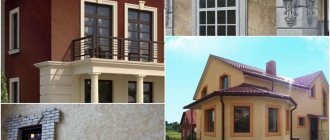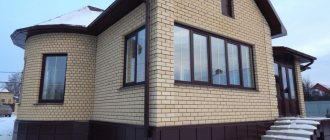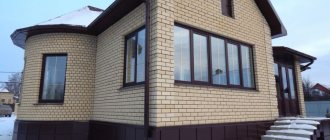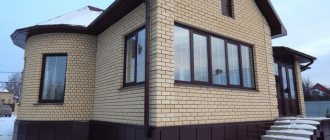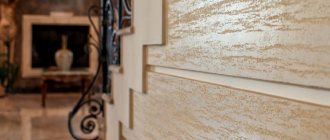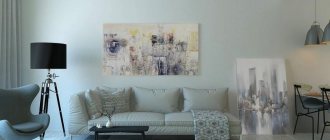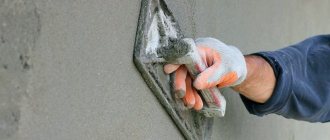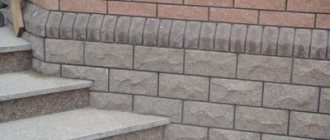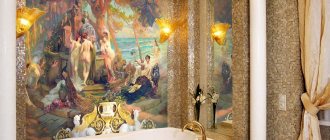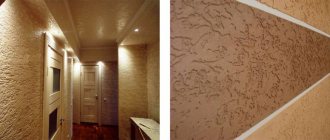Plastering is one of the popular methods of finishing facades. Its popularity is associated with ease of execution, affordable price and a large selection of texture options. This type of finishing is universal - it can be used to decorate both a private home and an office building. In this article we will look at what types of plasters are suitable for finishing the outside of a house.
Advantages of facade plasters:
- simplicity of application technology; you can plaster the walls outside the house yourself, even without experience in such work;
- good level of heat and sound insulation;
- resistance to air temperature changes;
- high level of strength;
- moisture resistance.
But besides the advantages, many types of decorative facade mixtures have a significant drawback compared to other finishing materials - this is a rather high price. But at the same time they have a small consumption of 2–3.5 kg per 1 m2.
Types of plaster for exterior use
Binders, sand, liquid glass, and acrylic resin are added to the material for finishing facades. These substances make it plastic, frost-resistant, and prevent cracking.
- Leveling plaster, which is used for rough finishing of walls.
- Special plasters contain fillers that enhance their functional qualities. When making a heat-insulating mixture, foam glass, polystyrene foam, and foamed perlite are added. The waterproofing mixture contains bitumen, crumb rubber, epoxy and acrylic resins, and latex. Pumice chips, expanded clay, and aluminum powder are added to soundproofing plaster.
- Decorative plaster is used for finishing the facade and gives the building a complete aesthetic appearance and expressiveness. They are produced in different colors, composition, texture. Venetian after hardening resembles marble, and stone resembles natural stone masonry.
Depending on the method of application to the facade, decorative plaster is divided into:
- Dry – slabs based on cement particle board,
- Wet - applying a layer of the mixture and then drying.
For construction teams, the cost of plastering facades is determined by calculating the price per 1 m2 and ranges from 350 to 550 rubles. If you follow the coating technology, you can do this work yourself.
Saving Tips
You can save significantly on plastering walls in an apartment only if you prepare the solution yourself and apply it yourself.
You can reduce costs a little more by using materials sparingly:
- Dilute the composition with water in small portions so that you have time to use it;
- Carefully monitor the differences in the wall; perhaps in some places it is enough to cut off the bumps and the mixture consumption will be reduced;
- Apply only two layers without covering, but this is acceptable if the differences do not exceed 1-2 cm.
Plastered walls improve the heat and sound insulation of the room, acquire a flat and smooth surface, ready for further finishing with thin coatings - wallpaper and paint. Some types of compositions also have decorative functions. You can apply the mixture in different ways, but it is important to do everything correctly, otherwise the coating will not last long.
Share in the comments your experience of applying rough and decorative plaster without any skills.
Types of facade plaster
In the manufacture of coatings, 4 types of binders are used. The service life, resistance to moisture, frost resistance, resistance to ultraviolet radiation, thermal insulation properties and the price of facade plaster depend on its type.
Mineral plaster for facade
Portland cement or lime is used as a binder. This is an affordable, budget version of the mixture, but with a small range of colors. Requires additional painting with facade paint. It goes on sale in bags of 25 kg in dry form.
Before use, dilute with water in a ratio of 1:3. Durable, moisture-resistant, frost-resistant coating, the disadvantage is that it cracks when vibrating. Apply to walls that have gone through the shrinkage stage to avoid cracking.
Acrylic plaster
Acrylic is made on the basis of acrylic polymer resins. Elastic plaster for the facade is capable of stretching and contracting when the wall or base is deformed, walls shrink, or vibrate. This prevents it from cracking.
But the resulting film does not withstand ultraviolet radiation; it fades and cracks. Its surface does not allow air to pass through from inside the room, so excess moisture accumulates in the building and the room does not breathe.
How to select and combine colors on the facade
The color of the outer covering is determined by the style of construction and the wishes of the customer. When selecting, they take into account the color scheme of window frames, doors, roofs, the shape of the walls, national traditions, and the purpose of the building. The most common finishing option is the white facade of the house with plaster. It is perfect for a building for any purpose; if necessary, it can be easily tinted, does not require complex coloring, and such a structure looks aesthetically pleasing and presentable.
For a private home, light shades are selected that harmoniously highlight the details of the structure and evoke warm emotions. Office buildings and government institutions are painted either in neutral, bright, noticeable colors: gray, red, light brown, yellow.
To correctly guess the color of a building, you can use expert advice:
- Simple architectural forms accept rich shades. Complex, with an abundance of columns, bay windows, winding and stepped structures - will look advantageous in a pastel, light color palette;
- No more than 2-4 colors are used in decoration so that the building looks organic and fits into the general appearance of the area;
- You can emphasize the color feature of the house with the help of textured finishes. A smooth surface enhances the perception of color, making the façade more noticeable and brighter. Relief, volumetric finishing mutes the color of the walls;
- Saturated shades quickly fade in the sun, dark colors increase the intensity of heating of the building;
- Using different shades you can visually hide design flaws;
- The roof and base are traditionally painted in darker colors, the walls in light colors;
- Natural, soft colors are perceived better than bright, too intense ones.
A house built according to a standard or individual design can be beautifully decorated, and at the same time insulated and protected using inexpensive materials. Making a modern, presentable, cozy home is not difficult. A wide selection of ready-made structures will serve as a guide.
Silicate plaster
Silicate - in production, potassium liquid glass is used as a binder. Sold as a dry mixture of 25 kg in bags or ready-made paste of 10 kg in a plastic container.
It has increased resistance to mechanical damage, is fireproof, frost-resistant, retains heat well, is not afraid of high humidity, is resistant to fading, and prevents the formation of mold and dirt.
Silicone plaster
Silicone as a filler contains synthetic rubber based on organosilicon compounds. Durable, moisture- and frost-resistant, withstands vibrations and shocks, is not afraid of sunlight, durable, the color range is represented by more than 200 shades.
Depending on the size of the filler particles, the wall surface is smooth, fine-grained, with small scratches and depressions, or loose, with deep grooves.
Coarse sand, small pebbles, granules, and rubber crumbs are used as fillers to obtain texture. Venetian plaster is applied in thin translucent layers, the number of layers can reach 9, imitates any natural material, even metal.
Stages of applying facade plaster
The application of the decorative mixture is carried out after the house or building has settled, usually after 2-3 years after completion of construction. When carrying out work, the average daily temperature should not be lower than +60 C, without night frosts and strong winds. No work is carried out during rain.
Before starting work, cover the brick and concrete wall with a layer of primer and let it dry. The maximum layer thickness is up to 4 mm; a thicker layer swells and cracks under its own weight.
At the preparatory stage, the wall is cleaned of grease and bitumen stains with an organic solvent, swept away from dust and dirt, if necessary, streaks of dried paint and cement are removed, recesses are leveled and irregularities of more than 2 cm are knocked down. The surface of the wall is primed or whitewashed with lime. This not only increases the adhesion of the plaster to the surface, but also prevents the development of mold.
The primer is applied to foam silicate blocks in 2-3 layers. Allow time to dry completely. The drying time is indicated on the packaging of the primer mixture.
Notches can be applied to brick and concrete walls for better adhesion of the material.
Beacons are installed on the wall, which are made from a strip of galvanized steel and have the shape of the letter T. Their size is 6x21 mm, and the length varies from 2.5 to 3 m. After applying the coating, they are removed, and the resulting recess is sealed with mortar.
Prepare a reinforced mesh, which is made of galvanized wire, fiberglass or polymer material. This increases the strength of the layer and the durability of the coating by 5 times, and increases the resistance to cracking and shedding of the facade. This allows you to avoid slipping and peeling of the plaster during its application and alignment on the wall of the building. The mesh is fixed to the base of the wall using dowels, self-tapping screws or directly with putty mesh.
The dry mixture is diluted with water as indicated in the instructions and allowed to brew for 15 minutes. To increase strength, PVA glue is added to the prepared solution. It allows you to increase the viscosity of the solution, which makes it easier to stretch on the surface.
The solution is spread onto the wall using a spatula or scooped onto the edge and applied to the wall. Rub evenly on the surface, making movements in one direction. You can use a long wooden rule that is guided along guide beacons.
The façade plastering technology involves carrying out work in small sections, since the mixture dries quickly and is difficult to stretch on the surface.
After plastering an area of up to 2 m2, the solution is allowed to dry and rubbed using foam or wooden floats. This is how they achieve a smooth, uniform surface on the entire wall, without sagging, breaks or depressions.
After drying, the wall can be painted if necessary.
Due to its light weight, wet plaster of the facade does not increase the pressure on the foundation, protects the house from moisture, retains heat, reduces noise levels, and thanks to a wide range of colors allows you to realize your wildest imagination.
Plastering technology for creating decorative surfaces
There are a huge variety of styles of material application. There are complex techniques where working alone is simply unacceptable.
Complex Travertino technique
Let's talk about the most common technologies:
- "fur coat";
- "bark beetle";
- "mosaic".
They will certainly decorate the facade of your home and make it unique.
"Fur coat"
“Fur coat” is a variant of interior and exterior wall decoration with a rough surface. To do this, you do not need to look for specialized material; the effect is achieved through a unique application.
Options for applying a “fur coat”
Covering the wall is not difficult, so this option is great for DIY application. The layer turns out dense and thick, it serves as additional sound insulation for the house. For the “fur coat”, they often use not ready-made solutions, but self-made ones based on cement and sand.
Let's talk about four options for applying such a decorative layer:
- Using a roller with holes or made of fur. For this, a liquid solution is used. If it seems thick, it is diluted with water or another product. The mixture is applied to the wall with a spatula, and then it is rolled out over the surface using a roller.
- Using a spatula, apply the mixture to the wall, smooth it out, and then use a trowel to create a texture. This method is the simplest and can be used by beginners. To create the design, apply a trowel to the wall while the plaster is wet, and then quickly remove it. You will get a “fur coat”.
- You can also create a pattern using a special sprinkler. It is very convenient to work using mechanical means.
- The last option is to imitate the design using a broom. A new one is sprayed onto the applied thin smooth layer by sharp swings of a broom, previously lowered into a bucket of solution.
Creating texture using a fur roller
"Bark beetle"
Perhaps the most popular type of solution application. Externally, the surface resembles wood eaten away by beetles, hence the name.
Surface "bark beetle"
For such work, specialized ready-made solutions, as well as dry mixtures, are offered. First, a smooth layer of plaster is applied. As soon as it starts to dry out and stops shining, start rubbing it with a trowel. The design options “rain”, “lamb”, “carpet” depend on how the hand movements are made (horizontally, vertically, diagonally, in a circle).
The wall is made using the “bark beetle-rain” technique
A short video will help you decide on the technique:
Related article:
Do-it-yourself technology for applying bark beetle plaster. In this publication we will look at detailed step-by-step instructions for applying the bark beetle, the nuances of painting the finished coating, a review of textured plaster manufacturers, average prices, and useful tips.
Mosaic
This option looks very impressive, and came to us from antiquity. The material contains marble, malachite, lapis lazuli chips, fractions up to 3 mm in size.
"Mosaic" option
The application technique is simple: using a grater, the mixture is pulled from one corner to another without drying out. You need to work quickly so that the joints are not visible.
